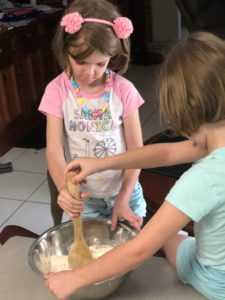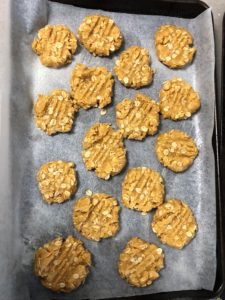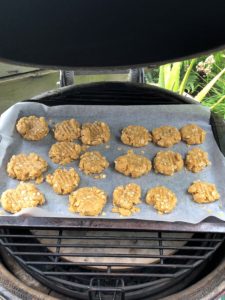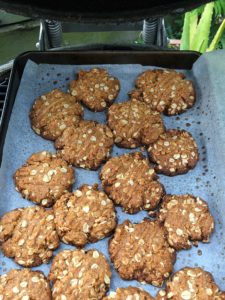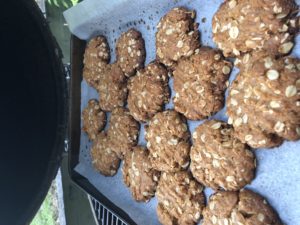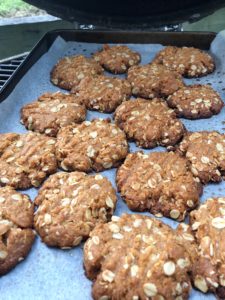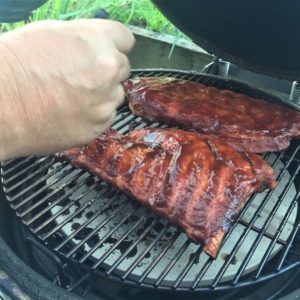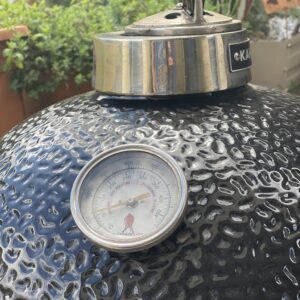ANZAC Biscuits on the Kamado Joe
Something a little different today.
Anzac biscuits on the Kamado Joe.
After firing up the Kamado Joe for some lunchtime sausages, which were delicious, I took the opportunity to make some Anzac biscuits with my daughters. They were very excited!
A quick google for a recipe and a check of the cupboard for all the ingredients and we are in luck.
Here is the recipe that got the nod. No thought other than I had the ingredients and it was the first result I looked at from google
Recipe
Ingredients
- 2 cups rolled oats
- 2 cups flour
- 2 cups coconut
- 1 1/2 cups sugar
- 250g butter
- 4 tbsp golden syrup
- 1 tsp baking soda
- 2 tblsp boiling water
Method
- Turn oven KAMADO to 160°C. Lightly grease oven trays.
- Place oats, flour, coconut, sugar in big mixing bowl.
- Melt butter and golden syrup in a saucepan. Take off heat.
- Mix baking soda and boiling water in a cup. Add to melted butter mixture in the pan. Quickly add to big mixing bowl. Mix well.
- Roll tablespoonfuls of the mixture into balls. Place on trays 5cm apart. Press lightly with a fork.
- Bake for 20 minutes.
Credit: https://www.kidspot.com.au/kitchen/recipes/anzac-biscuits-200
Cooking with kids (5 & 6) can be challenging, but fun if you can keep them involved and engaged. I try to pre-measure everything and be well prepared before they start. This gives them a sense of ownership of the tasks they are given, but in a well contained “box”. Also lets me focus on letting them enjoy the moment without getting frustrated at trying to concentrate on the recipe with 1 million questions.
For this recipe it was quite simple for them, add the dry ingredients and stir. They loved it. The look of complete joy in being able to assist was magical. Then once I added the butter, they had a ball being able to form the biscuit balls and put them on the baking tray.
They turned out fantastic, just the way I like them. Firm on the bottom with a little bit of chewy goodness in the middle.
The Kamado Joe got a good workout today, fired up at lunchtime for sausages, cooked Anzac biscuits and finished off with another butterflied lamb roast – awesome day on the grill!
As a side note – some history on the Anzac biscuit.
An Anzac biscuit is a sweet biscuit, popular in Australia and New Zealand, made using rolled oats, flour, sugar, butter (or margarine), golden syrup, baking soda, boiling water, and (optionally) desiccated coconut. Anzac biscuits have long been associated with the Australian and New Zealand Army Corps (ANZAC) established in World War I.
The biscuits were sent by wives and women’s groups to soldiers abroad because the ingredients do not spoil easily and the biscuits kept well during naval transportation. Today, Anzac biscuits are manufactured commercially for retail sale.
Biscuits issued to soldiers by the Army, referred to as “Anzac tiles” or “Anzac wafers”, differ from the popular Anzac biscuit. Anzac tiles and wafers were hard tack, a bread substitute, which had a long shelf life and were very hard.
Contents
- 1 Origins
- 2 Current popularity
- 3 Legal issues
- 4 Recipe
- 5 References
Origins
During a speech to the East Otago Federation of Women’s Institutes, Professor Helen Leach, of the Archaeology Department of the University of Otago in New Zealand, stated that the first published use of the name Anzac in a recipe was in an advertisement in the 7th edition of St Andrew’s Cookery Book (Dunedin, 1915). This was a cake, not a biscuit, and there were no mixing instructions. A recipe for “Anzac Biscuits” appeared in the War Chest Cookery Book (Sydney, 1917) but was for a different biscuit altogether. The same publication included a prototype of today’s Anzac biscuit, called Rolled Oats Biscuits. The combination of the name Anzac and the recipe now associated with it first appeared in the 9th edition of St Andrew’s Cookery Book (Dunedin, 1921) under the name “Anzac Crispies”. Subsequent editions renamed this “Anzac Biscuits” and Australian cookery books followed suit. Professor Leach also said that further research might reveal earlier references to the name and recipe in Australia or New Zealand.[4]
Rather than being sent to the front lines for the soldiers to eat as some people think, ANZAC biscuits were commonly eaten at galas, fetes and other public events such as parades, where they were sold to raise money to support the war effort. At the time they were often called “soldier’s biscuits”, and the fundraising that was organised by the Patriotic Funds accumulated 6.5 million pounds to support New Zealand troops in the war.
Current popularity
Today, Anzac biscuits are manufactured commercially for retail sale. Because of their historical military connection with the ANZACs and ANZAC Day, these biscuits are still used as a fundraising item for the Royal New Zealand Returned Services’ Association (RSA) and the Returned and Services League of Australia (RSL). Special collectors old-style biscuit tins with World War military artwork are usually produced in the lead up to Anzac Day and sold in supermarkets, in addition to the standard plastic packets available all year. The official RSL biscuit is produced by Unibic under license.
A British (though still Australian-produced) version of the Anzac biscuit, supporting the Royal British Legion, is available in several major supermarket chains in the UK.
Legal issues
The term Anzac is protected under Australian law and cannot be used in Australia without permission from the Minister for Veterans’ Affairs; misuse can be legally enforced particularly for commercial purposes. Likewise similar restrictions on naming are enshrined in New Zealand law where the Governor General can elect to enforce naming legislation. There is a general exemption granted for Anzac biscuits, as long as these biscuits remain basically true to the original recipe and are both referred to and sold as Anzac biscuits and never as cookies.
This restriction resulted in the Subway chain of restaurants dropping the biscuit from their menu in September 2008. After being ordered by the Department of Veterans’ Affairs to bake the biscuits according to the original recipe, Subway decided not to continue to offer the biscuit, as they found that their supplier was unable to develop a cost-effective means of duplicating the recipe.
Recipe
Notably, Anzac biscuit recipes omit eggs because of the scarcity of eggs during the war (after most poultry farmers joined the war effort) and so that the biscuits would not spoil when shipped long distances.
Don’t forget to stop by the shop for the latest accessories for your grill
You may also wish to subscribe for the latest posts to be delivered to your inbox.
